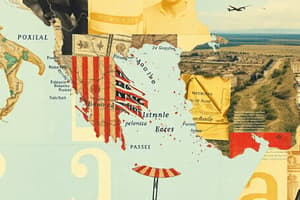Podcast
Questions and Answers
What geographical features isolate Egypt from potential invaders to the south?
What geographical features isolate Egypt from potential invaders to the south?
- Valleys
- High mountains
- Deserts (correct)
- Forests
Rome is located directly on the water, making it a major port city.
Rome is located directly on the water, making it a major port city.
False (B)
What is the primary river that provides water and fertile soil for agriculture in Egypt?
What is the primary river that provides water and fertile soil for agriculture in Egypt?
Nile River
The mountain range that runs down the center of the Italian Peninsula is called the __________.
The mountain range that runs down the center of the Italian Peninsula is called the __________.
Match the following terms with their descriptions:
Match the following terms with their descriptions:
Why was controlling the choke point in the Mediterranean significant?
Why was controlling the choke point in the Mediterranean significant?
Italy is primarily characterized by flat plains and smooth terrains.
Italy is primarily characterized by flat plains and smooth terrains.
What type of soil is commonly found in the region around Rome due to volcanic activity?
What type of soil is commonly found in the region around Rome due to volcanic activity?
The area where Rome is built is characterized by ____________ hills that surround a swamp.
The area where Rome is built is characterized by ____________ hills that surround a swamp.
What prevents easy north-south movement through Italy?
What prevents easy north-south movement through Italy?
Flashcards
Mediterranean chokepoint
Mediterranean chokepoint
A narrow strip of land that controls trade routes through the Mediterranean Sea.
Rome's central location
Rome's central location
Rome's location in central Italy gave it strategic control of the Italian peninsula.
Volcanic soil
Volcanic soil
Volcanic activity creates rich, fertile soil in Italy.
Nile River's Importance
Nile River's Importance
Signup and view all the flashcards
Nile River’s isolation
Nile River’s isolation
Signup and view all the flashcards
Italian Alps
Italian Alps
Signup and view all the flashcards
Italian peninsula's mountains
Italian peninsula's mountains
Signup and view all the flashcards
Rome's hills
Rome's hills
Signup and view all the flashcards
Pompeii & Herculaneum
Pompeii & Herculaneum
Signup and view all the flashcards
Italian climate
Italian climate
Signup and view all the flashcards
Study Notes
Mediterranean Geography and its Impact
- Mediterranean Chokepoint: Italy, Sicily, and Carthage are strategically located in the Mediterranean, creating a bottleneck controlling trade between the Western and Eastern Mediterranean. Controlling this point allows for significant influence over trade.
- Rome's Central Location: Rome is centrally located in Italy, giving it a strategic advantage to control the Italian peninsula. While not a port city itself, its central position enabled control of surrounding territory.
- Climate and Soil: Italy's climate is favorable, and the volcanic terrain creates rich black soil, supporting agriculture.
Nile River Significance
- Water and Transportation: The Nile River provides water and forms a waterway for travel and trade, flowing north into Egypt.
- Isolation and Growth: The Nile's cataracts and deserts isolate Egypt, facilitating its development without constant external threats.
- Agricultural Benefits: Annual flooding of the Nile deposits rich silt, creating fertile land for agriculture.
Italian Geography and Isolation
- Mountains as Barriers: The Alps mountains in the north and the Apennines running down the center of Italy limit movement and create natural barriers. This reduces the ease of invasions from the north.
- Rugged Terrain: Italy's terrain is largely mountainous or hilly, a significant factor shaping its historical development and interactions with surrounding regions.
- Volcanic Soil: Volcanic activity creates rich, dark soil, suitable for agriculture. Mount Vesuvius, a famous volcano, is located in Italy.
- Rome's Location: Rome is built on seven hills surrounding a swampy area. This location was initially less advantageous for easy access and required further development of the city's infrastructure.
Studying That Suits You
Use AI to generate personalized quizzes and flashcards to suit your learning preferences.




